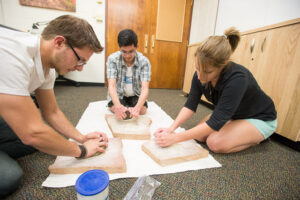Part II of Our Exploration of Equity in Interdisciplinary Evaluation
In Part I of our series on exploring equity in interdisciplinary evaluation, we discussed the importance of moving beyond disciplinary silo to embrace the unique ways of thinking and understanding that come from different disciplinary approaches. As evaluators, we view this uniqueness as an opportunity to create a vibrant, exciting team, where everyone is able to draw upon their unique strengths in the context of our shared goals. In this post, we explore two additional steps to support equity in interdisciplinary team evaluation.
Adopting a Cross-Disciplinary Approach for Effective Evaluation
So, what does an interdisciplinary evaluation strategy look like? Well, it starts with the goal of fostering a culture that values diverse perspectives and collaborative efforts. This emphasis in our evaluation approach mirrors the guidance of Harvard’s Collaborative on Academic Careers in Higher Education (COACHE) for recognizing interdisciplinary work in academic merit, promotion, and tenure processes for faculty members. Through open dialogue and a mixed-methods evaluation strategy, we aim to ensure that our evaluation processes reflect the intricate synthesis of experiences and expertise that define our academic community. In practice, this means we must leverage diverse insights and ensure our evaluative efforts reflect our broader commitments to inclusivity and equity.
- Leveraging Diverse Insights for Equitable Evaluation
As we’ve said already, drawing on multiple perspectives is key to crafting meaningful evaluations. You might be wondering how we incorporate these perspectives into our evaluation design. Current equity-focused evaluation strategies involve deliberate analysis of who is being served by a program and how outcomes vary across different groups, ensuring that our efforts contribute to minimizing inequalities. But, interdisciplinary collaboration has several layers that include promoting equity and inclusivity among the team themselves. For this, we turn to strategies outside evaluation to better understand the barriers to collaboration and success. By borrowing and blending practices from various disciplines, we’re not just evaluating; we’re learning and evolving along with the team, ensuring our assessments are as inclusive and equitable as possible.

- Keeping Equity at the Forefront
Equity is the foundation of evaluating interdisciplinary programs. This is especially crucial when programs are focused on aspects of diversity, equity, and inclusion in their target participant groups. For example, in Faculty Success, we seek to provide strategies for equity and success. With such a diverse faculty at various points in their careers, how can we ensure that programming is relevant and serving those that need it most? One step is to understand not only who participates and uses resources but who does not and why. This model of including voices while protecting potentially vulnerable groups models what the team strives to accomplish at a broader scale. As you may imagine, faculty engagement in this process becomes essential in translating these strategies into impactful interdisciplinary collaborations.
Nurturing Equity and Excellence Through Faculty Engagement
How can we all contribute to the success of interdisciplinary collaborations? Your active participation is essential whether you’re faculty, staff, or student. Engaging with the evaluation process together ensures these programs don’t just meet objectives but foster a thriving academic culture enriched by diverse perspectives.
Yet, evaluators can’t do this work alone. While we can provide insights and feedback, the real growth and innovation of interdisciplinary collaborations depend on you. Your commitment to applying changes and pushing these programs forward transforms good ideas into great outcomes. It’s the synergy of research, teaching, and evaluation—each contributing unique insights and strategies—that embeds equity throughout our collective actions.
A key action is to foster conversations on how equity influences the creation and evaluation of interdisciplinary work. These discussions are pivotal for shaping our daily interactions and building policies around recruitment, promotion, and tenure. Recognizing and rewarding interdisciplinary efforts creates a ripple effect that encourages richer exploration and creative innovation that can make equity and excellence a reality at CSU. Here, evaluation plays a critical role, serving as the lens through which we gauge our progress toward these ideals, ensuring our strategies effectively transform our academic environment.
So what’s your next step? Maybe it’s initiating a conversation with colleagues in your department, sharing a new interdisciplinary project idea, or exploring ways to integrate equity more deeply into your work. Integrating thoughtful evaluation into these steps is crucial—it’s how we measure impact, adapt strategies, and, ultimately, enhance our collective mission. Remember, the strength of our programs lies in our collective efforts, with evaluators ready to guide and support you every step of the way.
Author Information: This blog post was co-authored by Laura Sample McMeeking (she/her) and Christine Bell (she/her). Laura is an Associate Professor and the Executive Director of the CSU STEM Center, serving as the internal evaluator for the NSF Advance grant supporting Faculty Success. Christine is an evaluator and researcher at the Wisconsin Center for Education Research and the external evaluator for the NSF Advance grant supporting Faculty Success.
